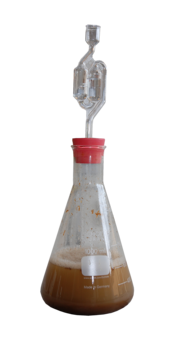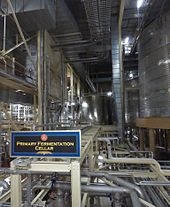Ethanol fermentation
Because yeasts perform this conversion in the absence of oxygen, alcoholic fermentation is considered an anaerobic process.
It also takes place in some species of fish (including goldfish and carp) where (along with lactic acid fermentation) it provides energy when oxygen is scarce.
In the first step of alcoholic fermentation, the enzyme invertase cleaves the glycosidic linkage between the glucose and fructose molecules.
Fermentation of sugar to ethanol and CO2 can also be done by Zymomonas mobilis, however the path is slightly different since formation of pyruvate does not happen by glycolysis but instead by the Entner–Doudoroff pathway.
If oxygen is present, some species of yeast (e.g., Kluyveromyces lactis or Kluyveromyces lipolytica) will oxidize pyruvate completely to carbon dioxide and water in a process called cellular respiration, hence these species of yeast will produce ethanol only in an anaerobic environment (not cellular respiration).
Yeast organisms consume sugars in the dough and produce ethanol and carbon dioxide as waste products.
This is because letting in outside air could contaminate the brew due to risk of bacteria or mold, and a buildup of carbon dioxide could cause the vessel to rupture.
[citation needed] Yeast fermentation of various carbohydrate products is also used to produce the ethanol that is added to gasoline.
[10] Although most of the fermentation plants have been built in corn-producing regions, sorghum is also an important feedstock for ethanol production in the Plains states.
[11] In some parts of Europe, particularly France and Italy, grapes have become a de facto feedstock for fuel ethanol by the distillation of surplus wine.
The starchy crop with highest energy content per acre is cassava, which grows in tropical countries.
Ethanol fermentation produces unharvested byproducts such as heat, carbon dioxide, food for livestock, water, methanol, fuels, fertilizer and alcohols.




